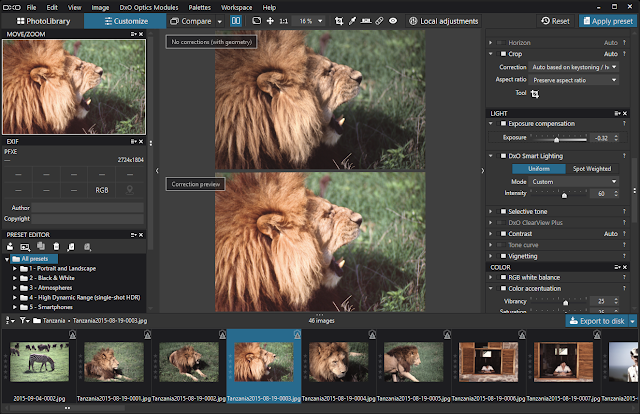

Meanwhile, the Smoothness control is helpful when you have large areas of uniform colour – or large areas that SHOULD be a uniform colour. The Detail slider controls the colour threshold and is useful for retaining colourful edges. You can also use the Detail and Smoothness controls to refine the colour noise reduction. You can click and drag on this to select a different area to preview, or click on the selection icon at the top left of the preview, then click on the part of the image that you want to see. The main image preview shows the impact of these settings, but there’s also a small preview window just above the controls that shows a section of the image at 100%. Gradually move the Color control to the right to conceal the noise, but keep an eye on the detail level and don’t overdo it. If you drag the sliding control to the left, reducing the value to 0, you’ll see the image with no noise reduction applied. The latest version of Lightroom Classic has six sliding controls over noise reduction, as a rule, it’s best to use the Color control first to remove the chroma noise (coloured speckling). Lightroom Classic’s noise reduction tools are located along with the Sharpening controls in the Detail section of the Develop control panel. Even a quick comparison is enough to see that DeepPRIME is a better noise reduction method that PRIME and HQ, but how does it compare against Lightroom’s noise reduction algorithm? It builds on DxO’s previous system, PRIME, which together with an even older noise reduction method (HQ), is still available in PhotoLab 4. DeepPRIME is powered by artificial intelligence and ‘deep learning’ to inform its ability to reduce the amount of noise visible in images without the smoothing and loss of detail that’s seen with some other noise reduction systems.

It also introduces the latest incarnation of DxO’s denoising technology, DeepPRIME. As well being able to correct optical flaws such as vignetting, lack of sharpness, chromatic aberration and distortion automatically, and giving you control to increase or reduce those corrections if you want, DxO PhotoLab 4 has a collection of controls for making global and local adjustments to the exposure, contrast and colour of images.
#NIX VS DXO PHOTOLAB 2 SOFTWARE#
However, it’s worth mentioning at this point that Fujifilm cameras with X-Trans CMOS sensors are a notable exception as the software is currently not compatible with their raw files.

DxO PhotoLab 4 is compatible with raw files from over 400 digital cameras and there are modules available for over 60,000 camera and lens combinations. This information feeds into DxO PhotoLab 4 in the form of correction modules that are downloaded and installed for each camera and lens combination used to create images. It combines an excellent cataloguing system with what many regard as industry-standard image editing controls, drawing on the same raw-file processing engine as Adobe Camera Raw.ĭxO, meanwhile, has a background in analysing lenses and cameras to enable it the correct their flaws. Adobe Lightroom Classic is the go-to image organisation and editing software for many photographers.


 0 kommentar(er)
0 kommentar(er)
